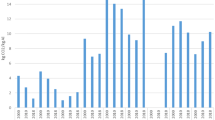Abstract
A cradle-to-gate life cycle assessment was conducted in this paper to calculate the greenhouse gas (GHG) emissions, such as CO2, CH4, CF4 and C2F6 emissions, based on statistic data of Chinese aluminum industry of the year 2003. The results showed that the GHG emissions for 1 t primary aluminum production was 21.6 t CO2 equivalent which is 70% higher than that of worldwide average level of the year 2000. The main contributors of emission were the alumina refining and aluminum smelting process accounting for 72% and 22% in accumulative emission, respectively. According to the development and application of new process technologies for primary aluminum production and the ‘target of energy-saving and emissions-reducing’ of Chinese government, the reduction potential of the GHG emissions for alumina and aluminum production were estimated. The results indicated that China aluminum industry would achieve the target of reducing about 25% GHG emissions by the end of 2010.
Similar content being viewed by others
References
Gu S Q. Alumina production technology with high efficiency and low consumption from Chinese bauxite resource (in Chinese). Chin J Nonf Metals, 2004, 14(S1): 91–97
Dai X P. Status and development of cleaner production in aluminium electrolysis process (in Chinese). World Nonf Metals, 2005, 6: 18–21
National Bureau of Statistics. China Statistical Yearbook in 2007 (in Chinese). Beijing: China Statistic Press, 2007
Editorial Board of the Yearbook of Nonferrous Metals Industry of China. The Yearbook of Nonferrous Metals Industry of China 2007 (in Chinese). Beijing: China Nonferrous Metals Industry Association, 2007. 503–504
Martchek K. Modelling more sustainable aluminium. Int J LCA, 2006, 11(1): 34–37
Norgate T E, Rankin W J. Greenhouse gas emissions from aluminium production-a life cycle approach. Proceedings of the International Symposium on Greenhouse Gases in the Metallurgical Industries: Policies, Abatement and Treatment. Toronto: Metallurgical Society of the Canadian Institute of Mining Metallurgy and Petroleum, 2001. 275–290
International Aluminium Institute. Life cycle assessment of aluminum: inventory data for the worldwide primary aluminium industry. London: International Aluminum Institute, 2003
IPAI Life Cycle Working Committee. Life cycle inventory of the worldwide aluminum industry with regard to energy consumption and emissions of greenhouse gases. http://www.world-aluminum.org/iai/publications/documents/full_report.pdf, 2000
Werner F, Richter K. Economic allocation in LCA: a case study about aluminium window frames. Int J LCA, 2000, 5(2): 79–83
Hayashi K, Okazaki M, Itsubo N, et al. Development of damage function of acidification for terrestrial ecosystems based on the effect of aluminum toxicity on net primary production. Int J LCA, 2004, 9(1): 13–22
Reginald H T, Hsien H K. An LCA study of a primary aluminum supply chain. J Cleaner Prod, 2005, 13: 607–618
Gerald R, Kurt B. The role and implementation of LCA within life cycle management at Alcan. J Cleaner Prod, 2005, 13: 1327–1335
Norgate T E, Jahanshahi S, Rankin W J. Assessing the environmental impact of metal production processes. J Cleaner Prod, 2007, 15: 838–848
Frees N. Crediting Aluminium recycling in LCA by demand or by disposal. Int J LCA, 2008, 13(3): 212–218
Gatti J B, de Castilho Quieroz G, Corrêa Garcia E E. Recycling of aluminum can in terms of life cycle inventory (LCI). Int J LCA, 2008, 13(3): 219–225
Wang Y B. The Applied Manual for Atmosphere Environment Engineer (in Chinese). Beijing: China Environment Science Press, 2003. 467–678
Institut für Umweltinformatik. Umberto User Manual (version 4). Germany Hamburg: GmbH, 2001
Di X H, Nie Z R, Yuan B R, et al. Life cycle inventory for electricity generation in China. Int J LCA, 2007, 12(4): 217–224
Huijbregts A J, Norris G A, Bretz Rolf, et al. Framework for modelling data uncertainty in life cycle inventories. Int J LCA, 2001, 6(3): 127–132
Wu Z X, Chen W Y. The Diversified Clean Energy Resources Strategies with Coal as the Backbone (in Chinese). Beijing: Tsinghua University Press, 2001
IPCC/OECD. Revised 1996 IPCC guidelines for national greenhouse gas inventories reference manual. Bracknell, U.K.: Intergovernmental Panel on Climate Change, 1997
Jeroen B G, Marieke G, Reinout H, et al. Life Cycle Assessment: An Operational Guide to the ISO Standards. Dordrecht: Kluwer Academic Publishers, 2001
Konrad S. Life cycle assessment of aluminum: inventory data for the worldwide primary aluminum industry. http://www.world-aluminium.org/cache/fl0000108.pdf, 2003
Koch M, Harnisch J. CO2 emissions related to the electricity consumption in the European primary aluminium production—a comparison of electricity supply approaches. Int J LCA, 2002, 7(5): 283–289
Liu J R, Liu X M. Application of treating middle and low grade bauxite by ore-dressing Bayer process in alumina production (in Chinese). Light Metals, 2005, 4: 11–14
Fu G F, Tian F Q, Quan K. Study on digestion of Chinese middle/low grade bauxite in lime Bayer process (in Chinese). J Northeastern Univ (Natl Sci), 2005, 26(11): 1093–1095
Li X B, Liu X M, Liu G H, et al. Study and application of intensified sintering process for alumina production (in Chinese). Chin J Nonf Metals, 2004, 14(6): 1031–1036
Author information
Authors and Affiliations
Corresponding author
Additional information
Supported by the National Natural Science Foundation of China (Grant No. 50525413), National Basic Research Program of China (973 Program) (Grant No. 2007CB613706), and Beijing Natural Science Foundation (Grant No. 2081001)
Rights and permissions
About this article
Cite this article
Gao, F., Nie, Z., Wang, Z. et al. Greenhouse gas emissions and reduction potential of primary aluminum production in China. Sci. China Ser. E-Technol. Sci. 52, 2161–2166 (2009). https://doi.org/10.1007/s11431-009-0165-6
Received:
Accepted:
Published:
Issue Date:
DOI: https://doi.org/10.1007/s11431-009-0165-6




